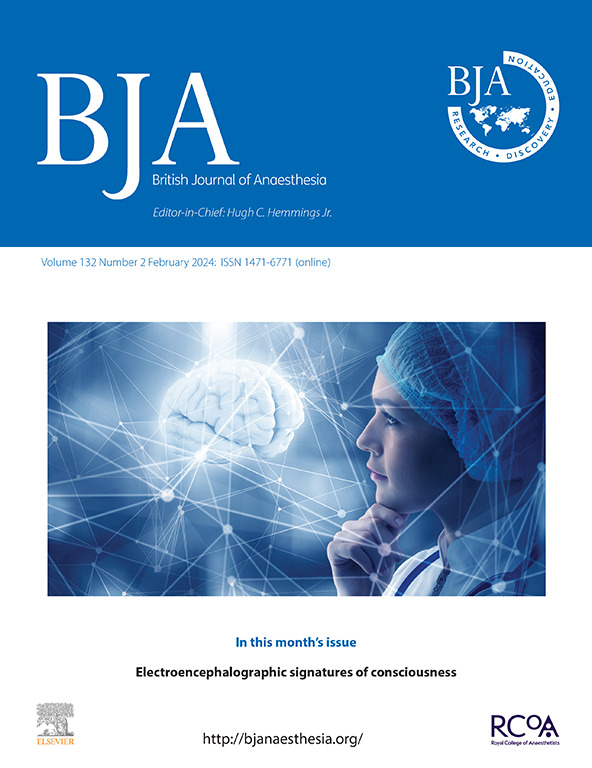Neurone-satellite glial cell interactions in dorsal root ganglia drive peripheral sensitisation in a mouse burn pain model.
IF 9.1
1区 医学
Q1 ANESTHESIOLOGY
引用次数: 0
Abstract
BACKGROUND Accumulating evidence suggests that glial mechanisms are pivotal in regulating chronic pain. Our previous findings revealed that the interactions between spinal microglia and astrocytes are crucial for burn-induced pain hypersensitivity. However, the mechanisms underlying burn-induced peripheral sensitisation remain incompletely understood. METHODS Sensory neurone-satellite glial cell (SGC) interactions within peripheral dorsal root ganglia were investigated using in vitro and in vivo experiments. Behavioural tests were conducted to evaluate the therapeutic potential of targeting peripheral sensitisation mechanisms for burn pain management. RESULTS Burn injury upregulated calcitonin gene-related peptide (CGRP) expression in sensory neurones (1.5-fold; P=0.013) through transient receptor potential vanilloid 1 (TRPV1) channels. Pharmacological blockade of the TRPV1/CGRP signalling pathway effectively attenuated burn-induced mechanical allodynia and thermal hyperalgesia. Additionally, neurone-derived CGRP triggered SGC activation (from 6.8% pre-injury to 41.6% at day 5 post-injury), concomitant with enhanced gap junction-mediated SGC coupling (from 16.7% pre-injury to 40.5% at day 5 post-injury). Furthermore, chemokine expression (particularly CXCL1) in SGCs was elevated after burn injury, which potentiated sensory neurone excitability and exacerbated pain hypersensitivity. Blocking SGC coupling exerted potent analgesic effects in this burn pain model. CONCLUSIONS A novel neurone-SGC interaction mechanism drives burn-induced peripheral sensitisation, providing translational implications for burn pain therapeutics.在小鼠烧伤疼痛模型中,背根神经节神经元-卫星胶质细胞相互作用驱动外周致敏。
越来越多的证据表明,神经胶质机制在调节慢性疼痛中起着关键作用。我们之前的研究结果表明,脊髓小胶质细胞和星形胶质细胞之间的相互作用对烧伤引起的疼痛超敏反应至关重要。然而,烧伤引起的外周致敏的机制仍然不完全清楚。方法采用体外和体内实验研究外周背根神经节内感觉神经元-卫星胶质细胞(SGC)的相互作用。进行行为测试以评估针对烧伤疼痛管理的外周致敏机制的治疗潜力。结果烧伤使感觉神经元中降钙素基因相关肽(CGRP)表达上调1.5倍;P=0.013)通过瞬时受体电位香草蛋白1 (TRPV1)通道。药物阻断TRPV1/CGRP信号通路可有效减轻烧伤引起的机械性异常痛和热痛觉过敏。此外,神经元源性CGRP触发SGC激活(从损伤前的6.8%增加到损伤后第5天的41.6%),同时伴有间隙连接介导的SGC偶联增强(从损伤前的16.7%增加到损伤后第5天的40.5%)。此外,烧伤后SGCs中的趋化因子表达(尤其是CXCL1)升高,增强了感觉神经元的兴奋性,加剧了疼痛超敏反应。阻断SGC偶联在该烧伤疼痛模型中发挥了强有力的镇痛作用。结论一种新的神经元- sgc相互作用机制驱动烧伤诱导的外周致敏,为烧伤疼痛治疗提供了翻译意义。
本文章由计算机程序翻译,如有差异,请以英文原文为准。
求助全文
约1分钟内获得全文
求助全文
来源期刊
CiteScore
13.50
自引率
7.10%
发文量
488
审稿时长
27 days
期刊介绍:
The British Journal of Anaesthesia (BJA) is a prestigious publication that covers a wide range of topics in anaesthesia, critical care medicine, pain medicine, and perioperative medicine. It aims to disseminate high-impact original research, spanning fundamental, translational, and clinical sciences, as well as clinical practice, technology, education, and training. Additionally, the journal features review articles, notable case reports, correspondence, and special articles that appeal to a broader audience.
The BJA is proudly associated with The Royal College of Anaesthetists, The College of Anaesthesiologists of Ireland, and The Hong Kong College of Anaesthesiologists. This partnership provides members of these esteemed institutions with access to not only the BJA but also its sister publication, BJA Education. It is essential to note that both journals maintain their editorial independence.
Overall, the BJA offers a diverse and comprehensive platform for anaesthetists, critical care physicians, pain specialists, and perioperative medicine practitioners to contribute and stay updated with the latest advancements in their respective fields.

 求助内容:
求助内容: 应助结果提醒方式:
应助结果提醒方式:


